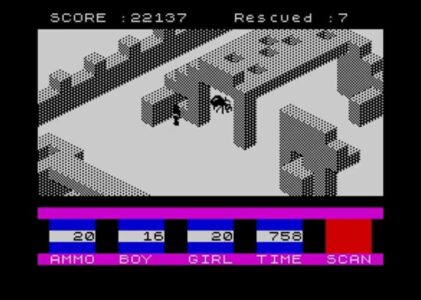Unearth the legacy of Ant Attack (1983), a groundbreaking isometric video game that revolutionized the gaming landscape.
Introduction
In the realm of video game history, few titles have left as lasting an impact as the revolutionary Ant Attack, released in 1983. Developed by Sandy White, this isometric adventure game marked a pivotal moment in gaming, introducing players to a unique perspective and captivating gameplay that defied conventions. Let’s delve into the captivating world of Ant Attack, exploring its genre, gameplay mechanics, key features, strategies, reviews, cultural impact, sequels, and similar games that followed in its innovative footsteps.
Ant Attack’s Genre and Platforms
Ant Attack, a pioneering isometric video game, falls within the action-adventure genre. Released initially for the Sinclair ZX Spectrum platform, the game later found its way onto other popular platforms of the era, including the Commodore 64 and Amstrad CPC. The game’s groundbreaking isometric graphics were a hallmark of its innovative design, providing players with a fresh perspective that set it apart from other contemporary titles.
Gameplay: Navigating the Ant-Ridden World
Ant Attack’s gameplay thrusts players into a dystopian cityscape overrun by gigantic ants. Players assume the roles of either a male or female protagonist, each with unique attributes, as they navigate through labyrinthine streets and buildings in an effort to rescue a captured friend. The game’s isometric viewpoint gives players an intriguing sense of depth, making navigation a challenging yet engaging experience.
Key Gameplay Features
Isometric Innovation
At the core of Ant Attack’s allure is its isometric graphical presentation. Unlike traditional top-down or side-scrolling views, the isometric perspective provides a three-dimensional appearance, immersing players in a dynamic and visually distinctive environment.
Exploration and Strategy
The game encourages exploration and strategic thinking. Players must uncover hidden paths, locate objects, and avoid or defeat the massive ants to progress. This blend of action and strategy set a new standard for gameplay, captivating players with a multifaceted experience.
Character Differentiation
Ant Attack’s introduction of distinct male and female characters was groundbreaking at the time. Each character possessed unique traits, impacting gameplay and strategy. This addition added an element of choice and replayability, as players could opt for different approaches based on their chosen character.
Time Pressure and Tension
Time pressure is a defining aspect of Ant Attack. As players race against the clock to rescue their friend, tension builds. The looming threat of the ants, coupled with the need to explore methodically, creates an adrenaline-pumping experience that keeps players on the edge of their seats.
Strategies and Cheats
Mastering Ant Attack demands a combination of strategic thinking, reflexes, and exploration skills. To outwit the formidable ants, players often adopt a blend of the following strategies:
- Pathfinding: Careful exploration and mapping of the cityscape is essential to identify safe routes and uncover hidden passages.
- Distraction Tactics: Manipulating the ants’ movement by baiting them with your character can provide brief reprieves or openings to dash to safety.
- Timing and Precision: Ant Attack’s time-sensitive nature requires precise movement and well-timed actions to navigate effectively.
- Ant Evasion: Learning to anticipate ant movement patterns and adapting on the fly is crucial for survival.
As with many classic games, Ant Attack also had its fair share of cheats, often discovered and shared among players. These cheats could provide various advantages, such as invincibility or altered enemy behavior. While cheats can offer a different dimension of play, they may also impact the challenge and satisfaction derived from the game’s intended experience.
Reviews and Cultural Impact
Upon its release, Ant Attack garnered widespread acclaim for its innovative design and engaging gameplay. Critics and players alike praised the game’s isometric graphics, which showcased a level of visual depth previously unseen in gaming. The strategic elements and tension-filled gameplay also drew praise, with many lauding the game’s ability to keep players hooked.
Ant Attack’s impact extended beyond the realm of gaming. The title contributed to the evolution of isometric graphics and gameplay mechanics, inspiring future game developers to explore new perspectives and design possibilities. The game’s influence can be observed in subsequent titles that embraced similar isometric viewpoints and innovative gameplay mechanics.
Sequels and Similar Games
Ant Attack’s success paved the way for sequels and inspired a wave of games that adopted its isometric approach and strategic gameplay. Sandy White’s own sequel, “3D Ant Attack,” continued to refine the formula, enhancing graphics and expanding gameplay features.
Beyond the Ant Attack series, numerous games drew inspiration from its isometric style and gameplay mechanics. “Knight Lore” (1984) by Ultimate Play the Game and “Sweevo’s World” (1986) by Microsphere are notable examples. These titles further explored the potential of isometric graphics and introduced new challenges and narratives.
Conclusion
The legacy of Ant Attack endures as a testament to the power of innovation in the world of gaming. With its pioneering isometric graphics, strategic gameplay, and enduring influence, the game remains a touchstone for developers and players alike. By pushing the boundaries of what was possible in the early 1980s, Ant Attack set a standard for immersive experiences that continues to shape the gaming landscape today.













